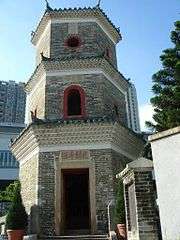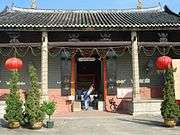Ping Shan Heritage Trail
Ping Shan Heritage Trail (Chinese: 屏山文物徑) is a heritage trail located in the Ping Shan area of Yuen Long District, in Hong Kong. The trail was inaugurated on 12 December 1993 and was the first of its kind in Hong Kong.[1] It passes through the villages of Hang Tau Tsuen, Hang Mei Tsuen and Sheung Cheung Wai and it includes several declared monuments and graded buildings.
The Ping Shan Tang Clan Gallery and Heritage Trail Visitors Centre was opened in 2007. It is housed in the Old Ping Shan Police Station.[2]
Sights included in the trail
The trail includes the following 12 historic buildings:
Tsui Sing Lau Pagoda

Tsui Sing Lau Pagoda (聚星樓) is Hong Kong's only ancient pagoda. The name in Chinese means "Pagoda of Gathering Stars". It became a declared monument on December 2001.
The Pagoda was built by Tang Yin-tung, the seventh generation ancestor, more than 600 years ago according to the genealogy of the Tang clan of Ping Shan. Oral history indicates the pagoda was originally a seven-storey hexagonal-shaped green-brick structure, but was damaged due to strong weather. At present it is a three-storey structure and it is about thirteen metres high. On the top floor, a statue of Fui Shing (Champion Star) is worshipped.
The pagoda was built to improve the feng shui of the locality so that flooding disasters were prevented to the village. It was also believed that its auspicious location, which is in alignment with Castle Peak, would ensure success for clan members in the Imperial Civil Service Examination. In fact, the Tang clan of Ping Shan has produced numerous scholars and officials.
Sheung Cheung Wai
Sheung Cheung Wai (上璋圍) is a walled village.
Yeung Hau Temple
It is one of the six temples in Yuen Long dedicated to Hau Wong.[3] It is a Grade III historic building.
Old well
.jpg)
On the trail between Yeung Hau Temple and Sheung Cheung Wai lies an old well that, according to the Tang villagers, was built by the residents of Hang Tau Tsuen more than 200 years ago and before the establishment of Sheung Cheung Wai, although the exact date of its construction cannot be traced. The well was once the main source of drinking water for both villages.[4]
Shrine of the Earth God
Not far away to the west of Sheung Cheung Wai lies a shrine dedicated to the Earth God who is known to the villagers as "She Kung". "She Kung" altars are commonly found in traditional Chinese villages as "She Kung" is believed to be the protector of villagers. "She Kung" is also known as "Pak Kung", "To Tei Kung" and "Fuk Tak Kung". The shrines for "She Kung" are usually simple brick structures on which pieces of stone are placed to symbolize the presence of the god.[5]
Tang Ancestral Hall

The Tang Ancestral Hall is one of the largest ancestral halls in the territory. It is located between Hang Mei Tsuen and Hang Tau Tsuen.[6]
It was constructed by Tang Fung-shun, the fifth generation ancestor of Tang Clan about 700 years ago.[7] It is the main ancestral hall of the Tang clan of Ping Shan. It is a three-hall structure with two internal courtyards. The wooden brackets and beams of the three halls are carved with auspicious Chinese motifs. Shiwan dragon-fish and pottery unicorns decorate the main ridges and roofs. There are ancestral tablets at the altar at the rear hall.[8]
This ancestral hall is still used regularly for worship and celebrations of traditional festivals and ceremonies, as well as a meeting place for the Tang clan of Ping Shan.[9]
Yu Kiu Ancestral Hall

Yu Kiu Ancestral Hall is situated adjacent to Tang Ancestral Hall, both declared monuments on December 14, 2001. There are three halls and two internal courtyards in the compound. The layout and design of Yu Kiu Ancestral Hall is the same as Tang Ancestral Hall.
It was built in the early sixteenth century by two eleventh generation brothers of the Tang clan of Ping Shan: Tang Sai-yin (alias Yu-sing) and Tang Sai-chiu (alias Kiu-lum). Apart from serving as an ancestral hall, the building was also used as a teaching hall for youngsters of Ping Shan. It was occupied by a primary School from 1931 to 1961. During the Guangxu reign (1875–1908) of Qing Dynasty, The last major renovation of the building probably took place; it was indicated by the engraved characters on the stone tablet above the main entrance.[10]
Kun Ting Study Hall
Kun Ting Study Hall was built for students preparing for the imperial civil service examination. It is a Grade I historic building.
Hung Shing Temple
This Hung Shing Temple was constructed by the Tang Clan residing in Ping Shan. It was probably built in 1767 during the Qianlong reign of the Qing Dynasty. The existing structure was rebuilt in 1866, followed by a substantial renovation in 1963.[11] It is a Grade II historic building.
Ching Shu Hin

Ching Shu Hin is an L-shaped two-storey building, adjoining Kun Ting Study Hall. It was constructed shortly after the completion of the Study Hall in 1870, and was used as a guest house.[12] It is a Grade I historic building.
Ping Shan Tang Clan Gallery cum Heritage Trail Visitors Centre
The Ping Shan Tang Clan Gallery cum Heritage Trail Visitors Centre was opened in 2007. It is housed in the Old Ping Shan Police Station.[2][13]
Entrance Hall of Shut Hing Study Hall
Shut Hing Study Hall was built in 1874 by the Tang clan to commemorate the ancestor, Tang Shut-hing. The rear hall of the Study Hall was demolished in 1977.[14] It is a Grade I historic building.
Other sights
Several other historic buildings located in the area covered by the trail are not officially part of the trail. They include:
Yeuk Hui Study Hall
Yeuk Hui Study Hall (若虛書室), located in Hang Mei Tsuen, is listed as a Grade III historic building.
Tat Tak Communal Hall
Tat Tak Communal Hall (達德公所) is located north-west of Sheung Cheung Wai. It is a Declared monument.
Sau Choi Mansion
Sau Choi Mansion (秀才故居) is a 160-year-old mansion, handed down through six generations. As its former residents, Tang Shut-hing and Tang Tai-shing obtained the official posts through imperial civil service examination, the house is now called Sau Choi Mansion.[15] The house was refurnished and now houses relics and information Tang clan. Tours are able to be arranged on Saturdays, Sundays and Public Holidays.
Yan Tun Kong Study Hall
Yan Tun Kong Study Hall (仁敦岡書室) is located in Hang Tau Tsuen. It is a declared monument.[16]
Sing Hin Kung Study Hall
Sing Hin Kung Study Hall (聖軒公家塾) is located in Hang Mei Tsuen. It is a Grade II historic building. Not open to the public.[17]
Ng Kwai Tong
Ng Kwai Tong (五桂堂) is a sub-family ancestral Hall in Hang Tau Tsuen. It was probably built in 1822.
See also
References
- ↑ "Ping Shan Heritage Trail". Antiquities and Monuments Office.
- 1 2 Ping Shan Tang Clan Gallery cum Heritage Trail Visitors Centre on Antiquities and Monuments website
- ↑ "Yeung Hau Temple". Antiquities and Monuments Office.
- ↑ Introduction on the Old well
- ↑ Introduction on the Shrine of the Earth God
- ↑ Education and Manpower Bureau: Ping Shan Heritage Trail: Tang Ancestral Hall
- ↑ "Tang Ancestral Hall". Antiquities and Monuments Office.
- ↑ "Tang Ancestral Hall". Antiquities and Monuments Office.
- ↑ Amy Ma Wall Street Journal "Doorway to the Past. Ancestral Homes Sustain an Old Way of Life", October 23, 2009
- ↑ "Yu Kiu Ancestral Hall". Antiquities and Monuments Office.
- ↑ Introduction to 1444 Historic Buildings, p.476
- ↑ "Ching Shu Hin". Antiquities and Monuments Office.
- ↑ Ping Shan Tang Clan Gallery cum Heritage Trail Visitors Centre
- ↑ "Entrance Hall of Shut Hing Study Hall". Antiquities and Monuments Office.
- ↑ Antiquities and Monuments Office. 2004 (DEC). Heritage Hong Kong (14)
- ↑ "Yan Tun Kong Study Hall". Antiquities and Monuments Office.
- ↑ Website about the sights along Ping Shan Heritage Trail (in French)
External links
| Wikimedia Commons has media related to Ping Shan Heritage Trail. |
- Ping Shan Heritage Trail on Antiquities and Monuments Office website
- Education and Monpower Bureau: Ping Shan Heritage Trail
- Ping Shan Heritage Trail photos and info - covers a walk along the trail, with photos en route.
- Ping Shan Heritage Trail blog
- Cheung, Sidney C. H. (1999). "The Meanings of a Heritage Trail in Hong Kong". Annals of Tourism Research. Elsevier Science. 26 (3): 570–588. ISSN 0160-7383. Retrieved 20 September 2014.
Coordinates: 22°26′42″N 114°00′26″E / 22.4449°N 114.0073°E